Preventing the frustration of calf scours
By Dr. Joe Gillespie
Calf scours is one of the most frustrating diseases on a dairy farm, affecting the youngest and most vulnerable members of the herd. According to a USDA National Animal Health Monitoring System (NAHMS) report, scours is the number one killer of preweaned calves.1
Even when calves recover, scours can have long-term effects on their health and productivity due to digestive tract damage. Also, weakened immune systems may open the door to other diseases. Research shows that preweaning diarrhea lowers weight gain, results in later first calvings and reduces first lactation milk production by nearly 10%.2,3
Hygiene, housing and nutrition all play crucial roles in preventing this devastating disease. But an often overlooked tool in scours prevention can be implemented even before the calf is born — through cow vaccination during the dry period.

We generally think of the dry period as a time of rest for the cow as she prepares her body for calving and the next lactation. But it’s also a time to support her unborn calf through the final weeks of growth and enhance its health after birth.
Unlike humans, antibodies from the cow do not cross the placenta. Therefore, the calf is born with a naïve, or immature, immune system. The only path for the dam’s antibodies to reach the calf is through colostrum. Feeding adequate amounts of high-quality colostrum soon after birth is the best way to supply the nutrients and antibodies calves need to fight against the pathogens they may be exposed to early in life.
Bolstering antibodies
An ideal management practice to bolster antibodies in colostrum is by vaccinating dry and close-up cows with BOVILIS® GUARDIAN®.
This killed virus vaccine develops immunoglobulins (IgG) or antibodies against scours-causing pathogens in the dry cow’s bloodstream. Those antibodies then transfer to colostrum prior to calving.
BOVILIS GUARDIAN protects against the four major bacterial and viral pathogens associated with calf scours:
- Rotavirus type G6
- Coronavirus types 1 and 3
- Clostridium perfringens types C and D
- E. coli type K99
Label directions call for an initial shot of BOVILIS GUARDIAN at dry-off, followed by a booster at three to six weeks prior to calving.
Calves are at the highest risk for calf scours in the first 10 to 14 days after birth. That’s why it’s important to get antibodies into the calf as soon as possible. That early protection is critical for the first 30 days of life. As calves get older, there are other options to vaccinate calves against both scours and respiratory pathogens.
Colostrum feeding guidelines
Even timely vaccination with BOVILIS GUARDIAN won’t be effective unless calves receive adequate colostrum. Follow these guidelines:
- Test collected colostrum with a Brix refractometer to ensure it contains the optimal level of IgG for immunity. Strive for IgG levels of at least 50g IgG/L.
- Feed three to four quarts of colostrum immediately after birth, ideally within the first hour. Feed two additional quarts about six to eight hours later.
- In total, the calf should receive colostrum equaling at least 10% of body weight within the first 12 hours of life. The ability to absorb IgG drops rapidly after birth. After 12 hours the calf is unlikely to absorb enough antibodies for immunity.
- If the calf has difficulty suckling, consider an esophageal tube feeder, but train workers in its proper use.
Other scours prevention practices
Dam vaccination and colostrum can’t do the scours prevention job alone. Keep in mind these other best management practices:
- Keep the calf environment clean and well ventilated.
- House young calves in individual pens to prevent pathogen transfer.
- Avoid overcrowding in group pens.
- Provide calves with proper nutrition and adequate water.
When you consider the potential economic losses due to scours in young calves, it makes good sense to vaccinate dry cows with BOVILIS GUARDIAN. Providing antibodies to calves through colostrum is a simple, yet vital way to give calves the best chance of becoming healthy herd replacements. Consult with your veterinarian on a dry cow vaccination program that fits your dairy’s goals and pathogen risks.
Resources
- National Animal Health Monitoring System, Health and Management Practices on U.S. Dairy Operations. 2014.
- Abuelo, A., Cullens, F., Brester, J.L. Effect of Preweaning Disease on the Reproductive Performance and First-Lactation Milk Production of Heifers in a Large Dairy Herd. J. Dairy Sci. 2021, 104, 7008–7017.
- Carter, H.S.M., Renaud, D.L., Steele, M.A., Fischer-Tlustos, A.J., Costa, J.H.C. A Narrative Review on the Unexplored Potential of Colostrum as a Preventative Treatment and Therapy for Diarrhea in Neonatal Dairy Calves. Animals. 2021, 11, 2221. doi: 10.3390/ani11082221
Find more content for your dairy operation.
About the author

Joe Gillespie, DVM
Dairy Technical Services Veterinarian
Merck Animal Health
